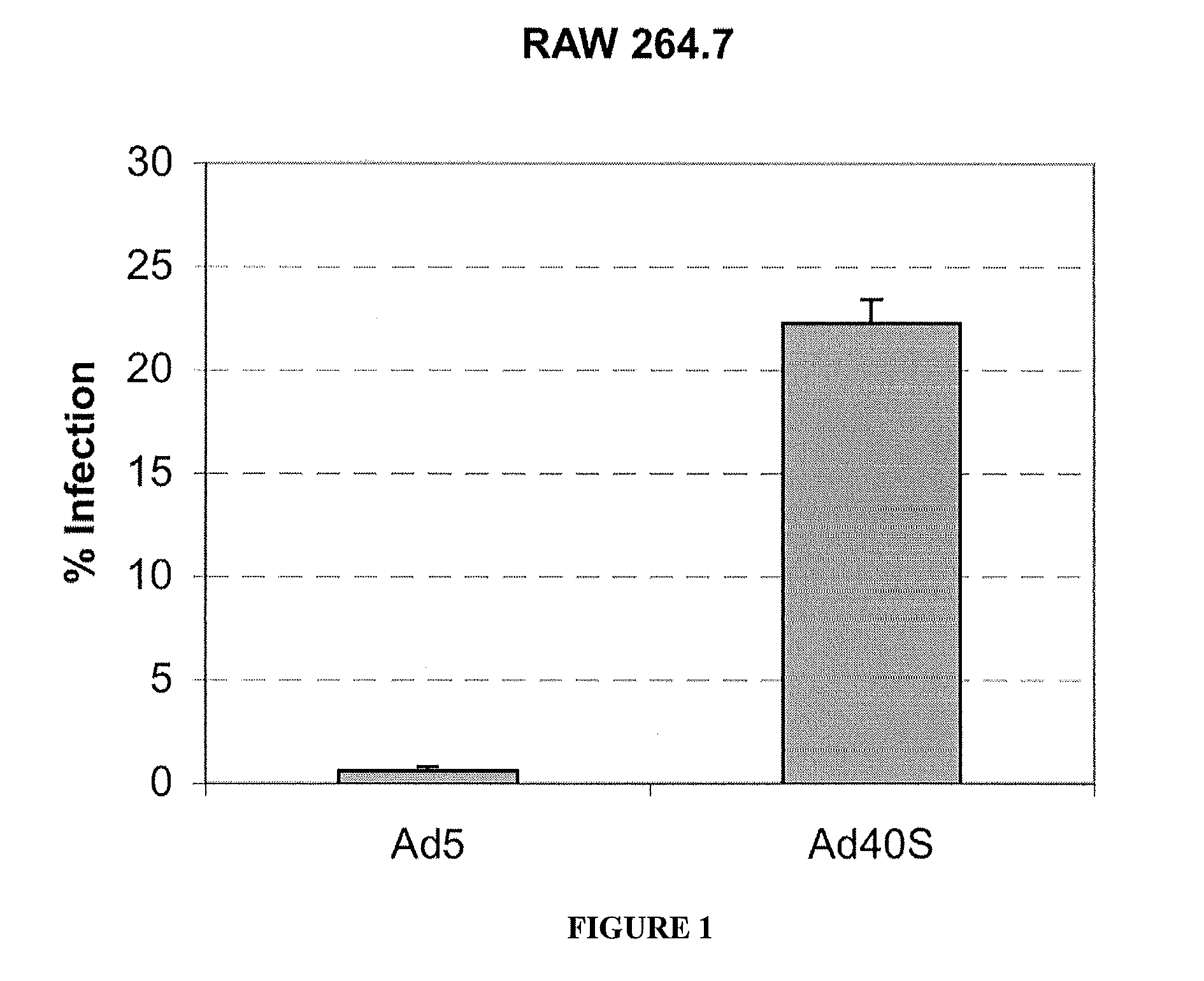Methods and reagents for efficient and targeted gene transfer to monocytes and macrophages
a gene and macrophage technology, applied in the direction of dna/rna fragmentation, macrophage non-active ingredients, viruses, etc., can solve the problems of secondary effects, no undifferentiated and unstimulated monocytes, and no particular efficiency of these vectors
- Summary
- Abstract
- Description
- Claims
- Application Information
AI Technical Summary
Benefits of technology
Problems solved by technology
Method used
Image
Examples
example 1
Ad5 / 40 is Capable of Transfecting Intestinal Mucose Mouse Macrophages
[0153]Recombinant Ad5 / 40-GFP were administered orally and intrarectally to mice. Green fluorescence was observed at the submucosal level in intestinal tissue sections. Since the presence of resident macrophages in this area is common even in healthy animals, we decided to assess whether Ad5 / 40 could efficiently transfect mouse macrophage cell lines. RAW 264.7 cells were cultured and infected with Ad5 / 40-GFP at 250 PP / cell (FIG. 1). Interestingly, the efficiency of infection was clearly greater than that of the Ad5 at the same conditions. Therefore, the results confirmed that Ad5 / 40 could efficiently transfect mouse macrophages.
example 2
Ad5 / 40 is Capable of Transfecting Human Monocyte-Derived Macrophages
[0154]Next, the ability of Ad5 / 40 to efficiently transfect human monocyte derived macrophages was tested. For this purpose THP1 (good infectivity using Ad5) and U-937 cells (very low infectivity using Ad5) were cultured in the absence of any differentiation factor that might induce maduration of monocytes to macrophages (such as LPS, PMA, etc). At this stage, the culture medium was changed to infection medium and 250 physical particles / cell of Ad5 / 40-GFP or 250 physical particles / cell of Ad5-GFP were added. Flow cytometry analysis of the supernatant fraction of the different cultures revealed higher percentage of transduced cells and higher GFP expression in the cultures infected by the Ad5 / 40 vector after 48 h, thus confirming the superior efficiency of this vector in the transfection of human monocyte cell lines (FIG. 2).
example 3
Ad5 / 40 is Capable of Transfecting Peripheral Blood Monocytes
[0155]Next, it was tested whether Ad5 / 40 was able to transfect peripheral blood monocytes.
[0156]For this purpose mononuclear cells (i.e lymphocytes, monocytes and NK cells) were obtained from buffy coats from healthy human donor's blood. Interestingly, the Ad5 / 40 was able to selectively infect peripheral blood monocytes, despite the fact that they represent on average only 8% of total mononuclear blood cells (FIG. 3). In fact, at a dose of 250 physical particles per cell, infection is not only more efficient in the case of Ad5 / 40 compared to Ad5 (66% vs. 15%) (FIG. 4), but was extremely selective as more than 99.9% of the Ad5 / 40 infected exclusively CD14+ cells (monocytes).
PUM
| Property | Measurement | Unit |
|---|---|---|
| Immunogenicity | aaaaa | aaaaa |
Abstract
Description
Claims
Application Information
 Login to View More
Login to View More - R&D
- Intellectual Property
- Life Sciences
- Materials
- Tech Scout
- Unparalleled Data Quality
- Higher Quality Content
- 60% Fewer Hallucinations
Browse by: Latest US Patents, China's latest patents, Technical Efficacy Thesaurus, Application Domain, Technology Topic, Popular Technical Reports.
© 2025 PatSnap. All rights reserved.Legal|Privacy policy|Modern Slavery Act Transparency Statement|Sitemap|About US| Contact US: help@patsnap.com



